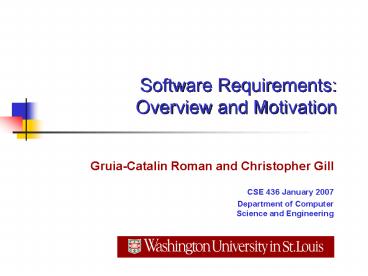Software Requirements: Overview and Motivation - PowerPoint PPT Presentation
1 / 15
Title:
Software Requirements: Overview and Motivation
Description:
Systems are being delivered late and over budget. Denver Airport (losses of $1.1 million/day) ... due to emerging gaps between projected capabilities and ... – PowerPoint PPT presentation
Number of Views:16
Avg rating:3.0/5.0
Title: Software Requirements: Overview and Motivation
1
Software RequirementsOverview and Motivation
- Gruia-Catalin Roman and Christopher Gill
- CSE 436 January 2007
- Department of Computer Science and Engineering
2
Overview of Requirements Topics
- 1 Software Crisis (the motivation)
- 2 Life-Cycle Perspective (the context)
- 3 Software Requirements (the ideas)
- 4 Processes (applying the approach)
- 5 Products (results and artifacts)
- 6 Basic Methods (foundational techniques)
- 7 Complex Models (advanced techniques)
- 8 Reviews (evaluation and feedback)
3
1. Software Crisis (the motivation)
- Overview
- 1.1 Symptoms
- 1.2 Causes
- 1.3 Costs
- 1.4 Response
4
1.1 Symptoms
- Systems are being delivered late and over budget
- Denver Airport (losses of 1.1 million/day)
- FAA (1 billion over budget, five years late)
- Systems under development are canceled
- due to emerging gaps between projected
capabilities and understood needs - two out of six major projects suffer this fate
5
1.1 Symptoms, Continued
- Completed systems meet the needs of the user only
in part - Some needs may never have been captured
- Capture may not have been rigorous / detailed
- Needs may have been out of scope for or time
budgets - Completed systems are never installed
- These problems are not limited to large and
complex systems
6
1.2 Causes
- Complexity
- System requirements
- Weak management controls
- Lack of technical maturity
7
1.3 Costs
- The cost of correcting an error grows very
rapidly as the project moves along its life-cycle - This observation argues for early error detection
and provides the motivation for technical reviews - The highest cost errors are those involving the
systems requirements formulation
8
Implications
- Problems relating to the identification and
documentation of system requirements - present the highest risk for a project
- Investments in other areas of the software
development process can be easily undercut - Costs incurred by problems with the requirements
- take away time and from design,
implementation, testing, upgrades, etc.
9
Implications, Continued
- Meaningful measurement and evaluation must
consider the key relation between - error introduction points
- error detection points
- Otherwise errors can persist, even propagate
- Limits effectiveness of the quality assurance
- Introduces weaknesses in development process
10
1.4 Response
- There is no silver bullet for the very difficult
task of requirements definition and management - The state of the art, however, is very much ahead
of the state of the practice - What you learn in this course, you can apply with
impact - A standardized framework can be the conduit for
bridging the gap - increased awareness
- common terminology
- assimilation of very basic practices
11
Capability Maturity Model
- Capability Maturity Model (CMM)
- A framework designed to facilitate the
introduction of basic sound practices across the
industry - CMM does not solve the technical problem
- CMM facilitates the adoption of sound technical
and managerial practices
12
Repeatable Level
- Key process areas
- Requirements management
- Software project management
- Software project tracking and oversight
- Software subcontract management
- Software quality assurance
- Software configuration management
13
Requirements Management
- Goals
- Requirements are controlled to establish a
baseline for technical and managerial use - Plans, products, and activities are kept
consistent with the requirements - Commitment to perform
- The project follows a written organizational
policy for managing system requirements
- Ability to perform
- Responsibility is established for analyzing and
allocating the requirements - Requirements are documented
- Resources are provided for managing the
requirements - Training is provided
14
Performance
- Activities performed
- Requirements are reviewed prior to use
- Requirements are used as a basis for plans,
products, and activities - Changes to allocated requirements are reviewed
15
Controls
- Measurement and analysis
- Measurements are made and used to determine the
status of the activities for managing the
requirements - Verifying implementation
- Activities for managing requirements are reviewed
with senior management - Activities for managing requirements are reviewed
with the project manager - The software quality assurance group reviews
activities and products































